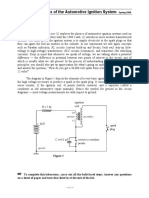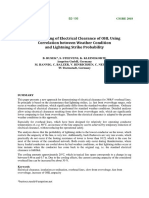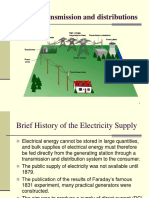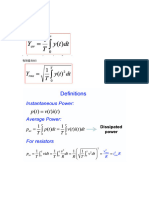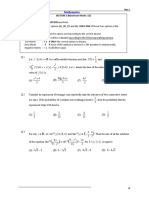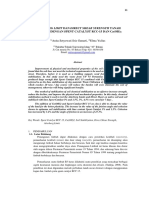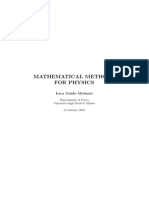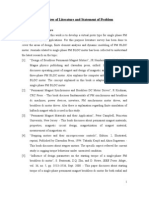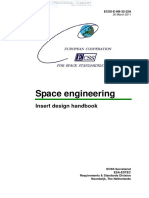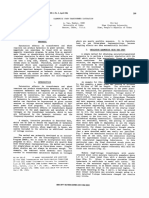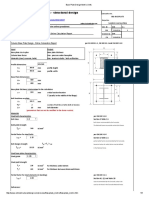2801
2801
Uploaded by
Ernesto GutierrezCopyright:
Available Formats
2801
2801
Uploaded by
Ernesto GutierrezOriginal Description:
Copyright
Available Formats
Share this document
Did you find this document useful?
Is this content inappropriate?
Copyright:
Available Formats
2801
2801
Uploaded by
Ernesto GutierrezCopyright:
Available Formats
Technical Data
A solenoid is a basic, rugged Saturation surface large enough to Maximum ON Time
device. Its component parts dissipate the energy (heat
consist of a coil (to carry Saturation of the iron path sink), or by resorting to Solenoids have a maximum
current and generate in a solenoid can be some other cooling method. ON time for a given duty
ampere turns), an iron shell considered in two ways. In When space permits, a cycle, wattage and power
or case (to provide a the true sense it is point (a) simple solution is to use a input. For example, if a
magnetic circuit), and a at which the iron ceases to larger solenoid. Heat in a solenoid is energized for
movable plunger or pole (to carry any increase in flux. solenoid is a function of one second out of four
act as the working element). In broader terms, power and the time during (25% duty cycle), its ON
saturation is usually which power is applied. For time is one second, which
A major objective in the considered as point (b), will cause no damage. On
design of a solenoid is to continuous duty, hold-in
where the iron begins to resistor circuits are the other hand, if the
provide an iron path saturate. solenoid is energized for 10
commonly used to provide
capable of transmitting minutes out of every 40
maximum magnetic flux higher starting torques/
forces than are obtainable minutes at the 25% duty
density with a minimum (a) cycle wattage, the duty
energy input. Another (b) at continuous duty rating.
cycle is still 25%, but its ON
objective is to get the best Our stock model standard time is now 600 seconds. A
B
relationship between the solenoids are designed to single pulse of this
variable ampere turns and operate in ambient duration would burn out
the working flux density in temperatures of -55°C to the solenoid. Ledex and
the air gap. When applying 80°C. A solenoid operating Dormeyer DC solenoids are
a solenoid, it is extremely H at the predetermined specified with two criteria
important to consider the conditions established in for maximum ON time:
effects of heat, since for a As the pole pieces are the coil data charts, with when pulsed repeatedly at
constant voltage moved together or when the specified heat sink, will the stated watts and duty
application, an increase in input power is increased, have a coil temperature cycle, and; for a single
coil temperature reduces the flux density of the rise of about 80°C (above pulse at the stated watts
the work output. magnetic circuit increases ambient temperature). Our (with the coil at 20°C
until the iron saturates near standard solenoids will ambient temperature).
Ambient temperature
point (b). Beyond this point withstand 120°C without
range, voltage fluctuation,
any further increase in thermal damage. A special
return springs and Operating Speed
power only serves to add high temperature coil with
temperature rise all affect
heat without an appreciable a 175°C temperature limit, The energizing time for a
the net output torque/force.
increase in force or torque. for operation in up to 95°C solenoid to complete a
For preliminary
By changing the iron path ambient, is available for given stroke is measured
calculations, we
area, the pole shape, or the rotary and low profile from the beginning of the
recommend that a 1.5
magnetic circuit material, solenoids. initial pulse to the seated
safety factor be applied to
output torque/force can be or energized position. For a
the variables.
increased. given solenoid, this time is
Duty Cycle dependent upon the load,
Magnetic Flux Ampere Turns
Duty cycle is determined by duty cycle, input power,
Magnetic flux lines are ON time/(ON + OFF) time. stroke and temperature
The number of copper wire For example, if a solenoid range. When a DC voltage
transmitted through the
turns, the magnitude of the is energized one second out is impressed across the
iron shell and the air gap
current, and permeance of of four seconds, the duty solenoid coil, the current
between the shell and the
TECHNICAL Information
the magnetic circuit cycle is 1/(1 + 3) = 1/4 or will rise to point (a) as
plunger (for linear
determine the absolute 25%. Duty cycle is the time shown on the graph below.
solenoids) or the armature
value of magnetic flux factor which determines
(for rotary solenoids). An
within the solenoid. The the permissible watts input
iron path is much more Steady State Current
permissible temperature and the subsequent amount
efficient than air, but the
rise limits the magnitude of of torque/force and heat. If,
Current
c
air gap is needed to permit
the power input. When for example, a 10-watt
movement of the plunger or
using a constant voltage, input power causes a heat b
armature. a
heat makes the coil less rise of 20°C in 10 seconds,
The force or torque of a
efficient because it reduces approximately the same
given solenoid is inversely
the ampere turns and, temperature rise will result
proportional to the square Time — Milliseconds
hence, the flux density and if a power of 100 watts is
of the distance between the
the torque/force output. applied for one second. In This time delay, which
pole faces. The lowest force
or torque is generated terms of duty cycle, a occurs prior to the plunger
Heat solenoid designed for motion, is a function of the
when the distance is
continuous duty can inductance and resistance
widest/longest; the Heat can be dissipated by
strongest when the distance dissipate ten times the of the coil, and the flux
controlling the air flow, by input power at 10% duty.
is smallest. required to move the
mounting the solenoid on a
saia-burgess Solenoids 1-800-998-2298 www.saia-burgess-usa.com/ledex Fax: 1-937-898-8624 I1
Technical Data
armature against the load. The length of the OFF time solenoid large enough to smaller solenoid and take
An increase in the or interval between pulses is provide the torque/force advantage of the higher
magnetomotive force is established by the duty cycle needed on a continuous torque/force obtainable
created by closing the air and the input power. If a basis or, if the application with an intermittent duty
gap (change in inductance) pulse train is applied for an permits a higher coil cycle input power. This can
as the plunger moves indefinite period, the temperature rise, he can be accomplished by using a
through the stroke, causing interval between pulses specify a smaller solenoid hold-in circuit to reduce
a dip in the current trace. should be sufficient to with a high temperature coil current to a point where
The cusp at point (b) maintain the duty cycle for to obtain continuous duty torque/force is sufficient to
indicates that the solenoid the input power and wire operation at a higher power maintain the solenoid in the
has completed the stroke. size tabulated in the coil level. He can also use a energized position.
The current trace then data tables. Response to a
begins to rise to a steady faster pulse rate for
“Hold-in” Resistor Value Estimates
state current value which, intermittent operation is
by Ohm’s law, is I = E/R. then limited by the 6K
4K
The current trace of a temperature rating of the
Hold-In Resistance - Ohms (20 Watts)
coil and the return speed of 2K
solenoid can be observed on
the plunger. The return
an oscilloscope by 1000
monitoring the voltage drop speed can be established by 800
600
reducing the OFF period
across a low resistance, 400
high wattage resistor in until the solenoid energizing
200
trace becomes erratic.
series with the solenoid coil. 100
When designing for high 80
At point (a) the solenoid 60
speed pulse trains, it is
has developed sufficient 40
flux to move the load. As important to consider the
20
type of coil suppression 15
the load increases, more
time is required to reach used, and the location of the 10
1 2 4 6 8 10 20 40 60 80 100 200 400 600 1000
control circuit.
point (c), as shown by the Coil Resistance - Ohms
A diode across the coil may
phantom current trace. If
the load is greater than the provide satisfactory coil
suppression, but it causes a
output of the solenoid, then
the coil will build to a slower collapse of the Mechanical Hold-in Resistor Circuit
magnetic field, lengthening
steady state value and a dip
the OFF interval required. + nc
in the trace will not occur
since the plunger has not Ledex high speed coil pb
suppressors use a diode/ normally closed
moved (top curve). switch actuated solenoid
capacitor/zener diode VDC
by solenoid coil
More time is required to principle to decrease the
complete the stroke within drop-out time as well as
the force limits of the – arc suppressor
effectively suppress
solenoid as the load transients. Placing the
increases, the power control switch to the Capacitor Hold-in Resistor Circuit
decreases, or the ambient solenoid on the AC side of a full wave rectifier
temperature increases, rectifier will have an effect plus capacitor
since these factors affect similar to that of using a pb
TECHNICAL Information
the net force of the diode across the coil. If de-
solenoid. energizing speed is critical, resistor
solenoid
When selecting a solenoid the control switch should be coil
for an application, it is located on the DC side of the
rectifier and a high speed 115 VAC
important that these arc suppressor
variables be taken into coil suppressor should be
consideration to determine used to provide adequate
the maximum length of the suppression while allowing
ON pulse. Once the fast plunger return speed. Transistorized Hold-in Circuit
N.O.
nominal energizing time
has been established, Continuous Duty
sufficient ON time beyond
For continuous duty
point (b) should be allotted
applications, or where there
to compensate for the
is a chance that an operator
change in speed due to the
might close the control
maximum load, minimum
switch for a long period, the
voltage, and maximum coil
project engineer has several
temperature.
choices. He can specify a
I2 saia-burgess Solenoids 1-800-998-2298 www.saia-burgess-usa.com/ledex Fax: 1-937-898-8624
Mechanical Hold-In Transistorized Temperature and Force/ Once the actual coil
temperature (ambient plus
Resistor Circuit Hold-In Circuit Torque Resistance rise) is determined, the
One of the more common As shown in the The force/torque curves resistance factor can be
methods to reduce coil transistorized circuit on page and coil data in this catalog determined as follows:
current is a normally closed H2, when the NO switch is are based on the coil being A size 3E, 31 awg coil has a
(NC) switch in parallel with a closed, current flows at an ambient temperature resistance of 31.8 ohms at
hold-in resistor. When push through the base-collector of 20°C, and the use of a 20°C. After operating for a
button (PB) closes the circuit, while the capacitor is heat sink comparable to that prolonged period at 10%
full voltage is impressed charging to input voltage. As called out in the notes duty, the approximate coil
across the solenoid coil, the base-collector current below each table. When a rise is 80°C. Added to 20°C,
bypassing the resistor flows, the emitter-collector solenoid is energized, the the coil temperature is
through the NC switch. As circuit allows full power to coil temperature rises. Since 100°C. The Resistance Factor
the solenoid approaches the be impressed across the resistance varies with graph indicates a 1.3 factor
end of its stroke, a solenoid coil. The transistor temperature, an increase in (point where 100°C and
mechanical connection is switched off when the temperature produces a diagonal intersect). At 100°C,
opens the NC contacts, capacitor reaches full proportional increase in the resistance of the 31.8
inserting the resistor in series charge. Current flow is then resistance. Increased ohm coil is increased by this
with the coil. This reduces through the hold-in resistor resistance reduces the factor. With a constant
the solenoid voltage to a and solenoid coil at current flow when constant voltage applied, the power
point where the power input continuous duty power or voltage is applied, and decrease is proportional to
is high enough to allow the less. When using this circuit, decreases the effective the resistance increase
solenoid to hold in, and yet it is important that the ampere turns and torque/ (P =E2⁄R). The 10% duty
stay within its normal heat transistor be on long enough force output. For each power of a size 3 solenoid is
dissipating range. to allow the solenoid to degree above or below 20°C, 90 watts (at 20°C). The
move the load through the the resistance of the coil’s decrease in power at the
Capacitor Hold-In complete stroke. copper wire changes by elevated temperature is
0.393 percent per degree. A calculated by:
Resistor Circuit The graph on page H2 is a
convenient guide to estimate coil temperature rise of
In some cases, a switchless 80°C, for example, will 90 (Power at 20°C)
hold-in resistor values. = 69 W
hold-in circuit may be used Because the actual value can increase the coil resistance 1.3 (Resistance Factor)
on 115 VAC applications. by a factor of 0.314, which is
vary according to the size of By interpolating between the
This consists of a capacitor the load to be held, it should equal to 80°C x 0.00393/°C.
which charges to a peak of Calculation of resistance at 25% and 10% duty cycle
be used only as a starting curves, the reduction in force
approximately 150 volts. A any other temperature (t2)
point. Keep in mind that
resistor in the line ahead of can be made using the due to the 80°C rise can be
more hold-in current (lower
the rectifier controls the following formula: estimated for a given stroke.
resistance) is needed as the
hold-in current after the hold-in load increases. To Rt2 = R 20°C [1 + 0.00393 (t2-20)]
discharged capacitor has use the graph, locate the coil
supplied the initial high Rearrangement of the
resistance on the horizontal
stored energy. formula produces a ratio
scale, then read the
between R20°C and Rt2 as
approximate hold-in resistor follows:
value on the vertical scale.
Rt2/R20 °C = 1 + .00393 (t2 - 20)
= Resistance Factor (R.F.)
TECHNICAL Information
The Resistance Factor of
2.0
copper wire at temperatures
from -60°C (-76°F) to 260°C
1.6 (500°F) is graphed below.
Resistance Factor (RF)
1.2
0.8
0.4
0
-76 .4 68 140 212 284 356 428 500
(-60) (-20) (20) (60) (100) (140) (180) (220) (260)
Coil Temperature - (Coil Rise + Ambient)
Fahrenheit (Centigrade)
saia-burgess Solenoids 1-800-998-2298 www.saia-burgess-usa.com/ledex Fax: 1-937-898-8624 I3
Technical Data
How to Simulate a Assume you have a 12-volt Input Power and Ohm’s Environmental
power supply and you want to
Coil Wire Size experiment with a size 3 low Law for Direct Current Considerations
If you have a stock model profile solenoid at continuous To understand the Factors which impact the
Ledex or Dormeyer duty. In the size 3 coil chart, relationships of power, operation and performance
solenoid, you can simulate the closest continuous duty current, voltage and of solenoids include:
performance with a different coil is 30 awg (13 volts). You resistance, use the chart • Temperature
wire gage by changing the can simulate the exact below. • Sand and dust
input voltage. A rule of conditions you would have • Humidity
thumb is that, as each wire with a 30 awg coil and a 12 • Shock and
size changes from one gage volt input by using a stock vibration
E2 E
to the next, the voltage model with (1) a 28 awg coil, R R
2
P • Altitude, vacuum
increases or decreases by or (2) a 33 awg coil. IR E
P
and pressure
the cube root of 2, or a P I • Specific application
factor of 1.26. (1) The size 3, 28 awg coil is EI R
rated at 8.4 volts, continuous E R E considerations such as
Coil data charts in this PR I paper dust and exposure to
duty. The desired 30 awg coil
catalog are tabulated with P E2 certain chemicals
is 2 gages higher. I P P
voltage values which provide IR I
2
Please consult an application
essentially constant ampere 12 (your voltage)
= 7.5 engineer, if any of these
turns for each wire size at 1.26 2 factors are prominent in your
given duty cycles. A stock (factor for two P = Power (watts)
planned solenoid design.
model solenoid with a given awg. changes) I = Current (amperes)
coil awg can be used to E = Electromotive force
simulate other wire gages 7.5 = voltage to simulate 30 (volts)
under different voltage awg coil at 12 volts when R = Resistance (ohms)
conditions as follows: using stock model size 3
with 28 awg coil.
(2) The 33 awg is rated at
26 volts, continuous duty.
The desired 30 awg is three
gages lower.
12 volts x 1.26 3 = 24
24 = voltage to simulate 30
awg coil at 12 volts when
using stock model size 3
with 33 awg coil.
TECHNICAL Information
I4 saia-burgess Solenoids 1-800-998-2298 www.saia-burgess-usa.com/ledex Fax: 1-937-898-8624
Technical Glossary of Terms
Air Gap Axial Stroke Coil Coining
The air space between the The amount of Copper windings The process of striking the
armature hub and the base longitudinal movement providing the electrical armature plate or case to
or the air space between the armature assembly element of the solenoid form the three ball races
the stationary and the travels as it rotates through which current is on rotary solenoids. This
moveable pole piece. through its stroke. Value passed to generate a process provides an
range from 0.022 to 0.100 magnetic field. Coils may extremely smooth, mirror-
Ampere Turns inches depending on be precision wound which like surface in the ball
The absolute value of solenoid size and length of allows the maximum races.
magnetic flux determined stroke. amount of copper in the
by the number of copper space provided or random Dielectric
wire turns in the coil and B-H Curve wound or bobbin wound. Dielectric is the resistance
the magnitude of the The graph of the ratio of between the coil and the
current. flux density to magnetic Coil Arc Suppression case. Minimum dielectric
Permissible temperature field intensity. The The application of value is 500 VRMS and
rise of the coil limits the magnetic field intensity is electronic protection range up to 1,500 VRMS
magnitude of the power usually plotted devices across switch depending on the solenoid
input. Heat makes the coil logarithmically. contacts and coils to size type and wire gage.
less efficient because it reduce the arc caused by Dielectric values are
reduces the ampere turns Bearing Balls interrupting the current shown for each solenoid in
and hence the flux density Precision stainless steel flow through an inductive the specifications chart.
and the torque or force balls used in rotary device such as a solenoid.
output solenoid ball races to Appropriate coil Dust Cover
provide essentially friction suppression greatly A protective sheet metal
Anchor Plate free rotary movement reduces this arcing. cover pressed over the
The thin formed sheet between the armature armature plate end of the
metal plate fitted over the plate and the case. Coil Resistance rotary solenoid to protect
mounting studs on the Coil resistance is the the armature and bearing
base of rotary solenoids to Bobbins property of the coil which balls from dirt and other
provide containment for Most bobbins are made of impedes the flow of contaminants.
the return spring. It has nylon 6/6 and meet UL file current through it when a
tabs formed up around the #E-41938 or E-39806B. voltage is applied. Duty Cycle
circumference which are Resistance values are ON Time/ON+OFF Time =
used to attach the end of Bobbin Wound Coil shown in ohms for each Duty Cycle. Standard duty
the spring and allow solenoid wire awg for a cycles used in this catalog
A coil, usually random
adjustment. temperature of 20°C. A are 100%, 50%, 25%, 10%
wound on a spool which
resistance conversion and 5%. Other values can
maintains the form and
Armature Assembly factor may be used to be determined by
shape of the coil and also
The assembly consisting of determine what the interpolation between any
provides the coil
the armature plate, the resistance would be at two columns.
insulation.
hub, and the shaft which is other temperatures. This
the complete moving Case is particularly helpful in Elongated Coils
TECHNICAL Information
element in a rotary determining the effects of
The outer shell and main These coils are 16%
solenoid. temperature on output
component of the solenoid longer than standard
torque or force. Use the
coil housing. Made of CRS precision wound rotary
Armature Plate resistance factor chart on solenoid coils, and provide
#1008, #1010, 12L14 or page I8 or refer to the
The large diameter plate 1215 case hardened to 513 30% more copper. These
Temperature and Force/
which forms the main on the Vickers scale units will provide
Torque Resistance section
rotating element of the (RC50) for sizes 0 to 6 approximately the same
on page I3 for further
solenoid and contains the (sizes 7 and 8 are not case torque with less wattage. If
calculation of resistance at
ball races which convert hardened). The case has the same wattage as the
temperatures other than
linear to rotary motion. the three coined ball standard precision coils is
20°C.
Made from SAE #1008 or races, and is formed from used, they will provide
1010 CRS and case flat stock drawn into a cup slightly more torque.
hardened for wearability (size 7 is machined from
in the ball races. bar stock and size 8 is Ending Torque
made from tubing stock Torque that a rotary
because of their size and solenoid develops in the last
thickness). degree or two of stroke.
saia-burgess Solenoids 1-800-998-2298 www.saia-burgess-usa.com/ledex Fax: 1-937-898-8624 I5
Technical Glossary of Terms
End Play Heat Rise Lubricant Needle Bearing
The amount of free axial The rise in temperature Standard rotary solenoids A bearing used in long life
movement built into a which results from are lubricated in the ball rotary solenoids which is a
rotary solenoid in the operating the solenoid at races and in the sleeve circle of long needles
completely de-energized the predetermined bearing with Nye forming the bearing
position. This axial conditions established in Rheolube #719L, a lithium surface for the shaft.
movement, normally only the coil data charts, with soap-based synthetic
a few thousandths of an the specified heat sink. hydrocarbon grease with Net Torque
inch, assures that the Standard solenoids will wide temperature The starting torque
solenoid is capable of have a temperature rise of capabilities from -54°C to available from the
returning to the completely 80°C over ambient. over 93°C. The base oil is solenoid after subtracting
de-energized position and compatible with most the nominal return spring
does not stop before the Heat Sink ester-vulnerable plastics torque.
balls reach the end of their The maximum allowable and elastomers. It contains
races. watts for each solenoid are a rust inhibitor and an PWM
based on an unrestricted ultraviolet sensitive dye.
Flux Density (Pulse Width Modulation)
flow of air at 20°C with the Endurance engineered
solenoids are lubricated If a solenoid is controlled
The number of Webers per solenoid mounted on the
with Shell Alvania #2 by a transistor which is
square meter in a cross equivalent heat sink
which is also a lithium signaled from a
section normal to the specified for each size.
soap-based grease with a microprocessor, the PWM
direction of the flux. This Inadequate heat sink or
temperature range of - can be considered as an
quantity is known as Tesla restricted air flow may
29°C to 121°C. alternate means for
and given the symbol B. result in overheating of
reducing sizes or saving
The typical knee in the B- the solenoid.
Magnet Wire energy. PWM reduces the
H curve where iron
Holding Torque effective voltage by
becomes difficult to further 100% copper wire, UL-
pulsing the voltage input.
magnetize is around 1.6 The torque required to recognized, single film
For example, if a solenoid
Tesla. break the armature loose insulation rated at 200°C
has 12 volts supplied, but
from the energized (Class H), meets UL file
Flux, Magnetic at 500 Hz at a 50% duty,
position while under E-37683 or E-34609. Also
the solenoid acts exactly
The physical manifestation power. Normally checked meets Federal
as if it is connected to a 6-
of a condition existing in a under continuous duty specification J-W-1177/13
volt supply. If the duty
medium or material operation and after or J-W-1177/14. Tubular
cycle is changed to 25%,
subjected to a magnetizing reaching the stabilized and Open Frame solenoids
then the solenoid performs
influence. The quantity is operating temperature. use single-build insulation
like one hooked to a 3-volt
characterized by the fact rated at 130°C. It is UL File
supply. The frequency
that an electromotive force Hub E-34609 or E-37683 and
must be higher than the
is induced in a conductor Part of the armature plate meets Federal
solenoid can respond to
surrounding the flux assembly which forms the specification J-W-1177/9.
otherwise chatter or
during any time there is a moving pole face. Made of humming will occur. Due
change in flux magnitude. Magnetic Field Intensity
12L14 or 1215 CRS. The to the inductive nature of
A unit of flux is a Weber shaft is pressed into the The closed loop integral of the solenoid coil, the
TECHNICAL Information
which is defined as that hub which is staked to the this quantity is equal to the current is smoothed
which being linearly armature plate. total current enclosed, as resulting in a constant
attenuated to zero in 1 defined by Maxwell’s force. Initially, the
second, induces in a Lead Wires equation. Or, the mag- microprocessor must leave
surrounding turn, an EMF netomotive force per unit the transistor on long
Standard temperature
of 1 volt. length in a magnetic enough to allow the
rated coils use PVC
circuit. This quantity is solenoid to energize. After
insulated stranded lead
Gross Torque given the symbol H. that point, the micro-
wire, UL style 1007 rated
The starting torque for 80°C at 300 volts. It processor must alternately
available from a rotary Magnetomotive Force issue ON and OFF pulses
also meets CSA type TR-
solenoid before subtracting 64, 90°C at 600 volts; and See ampere turns. to the transistor to achieve
the nominal return spring MIL-W-16878/2, 105°C at the appropriate duty cycle.
torque. 1000 volts. High
temperature coils use
Teflon Type E, TFE, and
meets MIL-W-16878/4A
rated at 200°C at 600 volts.
I6 saia-burgess Solenoids 1-800-998-2298 www.saia-burgess-usa.com/ledex Fax: 1-937-898-8624
Technical Glossary of Terms
Permeability Relative Permeability Safety Factor Sleeving
The ratio of flux density in The ratio of the flux The ambient temperature Sleeving used on standard
a given medium to the density in a given medium range, voltage fluctuation, solenoids to insulate the
magnetic field intensity. to that which would be return springs and lead wires where they exit
The symbol used is µ and produced in a vacuum temperature rise all affect the solenoid case is black
has the value of 4πE-7 in a with the same the net available output Vinylite per Mil-I-631B,
vacuum. magnetizing force. Non- torque or force of a Type F, subform Ua, Grade
magnetic materials, solenoid. A 1.5 safety C, Class 1, Category 1, and
Permeance including air, have a factor should be applied to meets UL file #E13565 and
The ratio of the flux relative permeability of 1, preliminary calculations of E-18459. Sleeving on high
through any given cross while magnetic materials torque or force. temperature coils is Teflon
section of a given medium such as iron, have initial for temperatures up to
(bounded by equipotential relative permeabilities of Shaft—Other Solenoids 200°C continuous and will
surfaces) to the difference around 2,000. The main axle of the meet the requirements of
in magnetomotive force solenoid which runs from AMS 3655 and UL file #E-
between the two surfaces. Residual Magnetism the armature through the 20344 and E-39513.
The magnetism which base and out the bottom
Plunger remains in effect on a and provides the main Starting Torque
The magnetic moving piece of magnetic material bearing. The shaft is also The torque which is
component of a linear or between two pieces of used for external produced by a rotary
solenoid, typically made magnetic material after attachment to the solenoid in the first degree
from cold, rolled steel. the electromagnetic field solenoid. Normally made or two of stroke from the
created by the coil has of non-magnetic #303 de-energized position.
Precision Wound Coil been removed. An air gap stainless steel. On long-life
is usually maintained rotary solenoid models the Stator Assembly
A coil whose individual
between two magnetic shaft is made of CRS That portion of any
turns have a prescribed
poles to minimize the #12L14 or 1215 which has solenoid which contains
pattern which they must
effects of residual been case hardened in the the coil, case and base.
follow during the winding
magnetism. bearing area for wear This portion remains
process whereby each turn
resistance. stationary during
is laid precisely next to the
Resistance Tolerance operation.
previous turn. This process
Coil resistance tolerances Shaft—Tubular Solenoid
allows for the maximum
amount of copper in the are generally ±5% for The small diameter Tape
allotted space. Normally heavier gage wires where portion of the plunger Coil wrapping tape is clear
carries a ±5% tolerance on precision coil windings assembly of a push-type Mylar brand polyester film
coil resistance. are used and ±10% for tubular solenoid which 0.002" thick which has
finer gage wire where protrudes through the been slit to the desired
Random Wound Coil random winding base or stationary pole width and is used to wrap
A coil whose turns are processes are used. face and provides push the coil in an overlapping
allowed to wind randomly Tolerances are shown for capability; usually made manner. The film is per
in no specific pattern. One each solenoid in the from #303 stainless steel. Mil-I--631 Type G, Form
turn may overlap another individual specification Tf, Class I, rated for 130°C
TECHNICAL Information
charts. Sleeve Bearing continuous and meets UL
or may lay side by side or
even spiral completely The cylindrical bearing in file #E-39505. Coil banding
Return Springs the base of the solenoid tape is Mylar polyester
across the surface of the
coil. Normally carries a All standard stock rotary which provides a guide for film, adhesive backed per
±10% tolerance on solenoids have scroll type the shaft. Usually made Mil-I-15126 Type MFT.
resistance return springs. Values from phosphor bronze, it This tape is used to wrap
range from 1 oz-in to 1 lb- can be made of other around the O.D. of the coil
in depending on the materials for different one thickness of 0.0025".
solenoid size. Tolerance applications requiring
on springs are ±20% of the longer life.
nominal value shown.
Return springs are an
available feature on any
solenoid.
saia-burgess Solenoids 1-800-998-2298 www.saia-burgess-usa.com/ledex Fax: 1-937-898-8624 I7
Technical Copper Resistance Factors
Because the resistance of copper wire varies with temperatures or the temperature if the resistance is
temperature, a given resistance must be compensated for known. (See Temperature and Force/Resistance Factor on
when it is measured at some other temperature. The chart page I3 for Resistance calculations.)
below can be used to determine the resistance at different
°C °F R.F. °C °F R.F. °C °F R.F. °C °F R.F.
-55 -67.0 0.70525 0 32.0 0.92140 60 140.0 1.15720 120 248.0 1.39300
-54 -65.2 0.70918 1 33.8 0.92533 61 141.8 1.16113 121 249.8 1.39693
-53 -63.4 0.71311 2 35.6 0.92926 62 143.6 1.16506 122 251.6 1.40086
-52 -61.6 0.71704 3 37.4 0.93319 63 145.4 1.16899 123 253.4 1.40479
-51 -59.8 0.72097 4 39.2 0.93712 64 147.2 1.17292 124 255.2 1.40872
-50 -58.0 0.72490 5 41.0 0.94105 65 149.0 1.17685 125 257.0 1.41265
-49 -56.2 0.72883 6 42.8 0.94498 66 150.8 1.18078 126 258.8 1.41658
-48 -54.4 0.7327 7 44.6 0.94891 67 152.6 1.18471 127 260.6 1.42051
-47 -52.6 0.73669 8 46.4 0.95284 68 154.4 1.18864 128 262.4 1.42444
-46 -50.8 0.74062 9 48.2 0.95677 69 156.2 1.19257 129 264.2 1.42837
-45 -49.0 0.74455 10 50.0 0.96070 70 158.0 1.19650 130 266.0 1.43230
-44 -47.2 0.74848 11 51.8 0.96463 71 159.8 1.20043 131 267.8 1.43623
-43 -45.4 0.75241 12 53.6 0.96856 72 161.6 1.20436 132 269.6 1.44016
-42 -43.6 0.75634 13 55.4 0.97249 73 163.4 1.20829 133 271.4 1.44409
-41 -41.8 0.76027 14 57.2 0.97642 74 165.2 1.21222 134 273.2 1.44802
-40 -40.0 0.76420 15 59.0 0.98035 75 167.0 1.21615 135 275.0 1.45195
-39 -38.2 0.76813 16 60.8 0.98428 76 168.8 1.22008 136 276.8 1.45588
-38 -36.4 0.77206 17 62.6 0.98821 77 170.6 1.22401 137 278.6 1.45981
-37 -34.6 0.77599 18 64.4 0.99214 78 172.4 1.22794 138 280.4 1.46374
-36 -32.8 0.77992 19 66.2 0.99607 79 174.2 1.23187 139 282.2 1.46767
-35 -31.0 0.78385 20 68.0 1.00000 80 176.0 1.23580 140 284.0 1.47160
-34 -29.2 0.78778 21 69.8 1.00393 81 177.8 1.23973 141 285.8 1.47553
-33 -27.4 0.79171 22 71.6 1.00786 82 179.6 1.24366 142 287.6 1.47946
-32 -25.6 0.79564 23 73.4 1.01179 83 181.4 1.24759 143 289.4 1.48339
-31 -23.8 0.79957 24 75.2 1.01572 84 183.2 1.25152 144 291.2 1.48732
-30 -22.0 0.80350 25 77.0 1.01965 85 185.0 1.25545 145 293.0 1.49125
-29 -20.2 0.80743 26 78.8 1.02358 86 186.8 1.25938 146 294.8 1.49518
-28 -18.4 0.81136 27 80.6 1.02751 87 188.6 1.26331 147 296.6 1.49911
-27 -16.6 0.81529 28 82.4 1.03144 88 190.4 1.26724 148 298.4 1.50304
-26 -14.8 0.81922 29 84.2 1.03537 89 192.2 1.27117 149 300.2 1.50697
-25 -13.0 0.82315 30 86.0 1.03930 90 194.0 1.27510 150 302.0 1.51090
-24 -11.2 0.82708 31 87.8 1.04323 91 195.8 1.27903 151 303.8 1.51483
-23 -9.4 0.83101 32 89.6 1.04716 92 197.6 1.28296 152 305.6 1.51876
-22 -7.6 0.83494 33 91.4 1.05109 93 199.4 1.2868 153 307.4 1.52269
-21 -5.8 0.83887 34 93.2 1.05502 94 201.2 1.29082 154 309.2 1.52662
-20 -4.0 0.84280 35 95.0 1.05895 95 203.0 1.29475 155 311.0 1.53055
-19 -2.2 0.84673 36 96.8 1.06288 96 204.8 1.29868 156 312.8 1.53448
-18 -0.4 0.85066 37 98.6 1.06681 97 206.6 1.3026 157 314.6 1.53841
-17 1.4 0.85459 38 100.4 1.07074 98 208.4 1.30654 158 316.4 1.54234
-16 3.2 0.85852 39 102.2 1.07467 99 210.2 1.31047 159 318.2 1.54627
TECHNICAL Information
-15 5.0 0.86245 40 104.0 1.07860 100 212.0 1.31440 160 320.0 1.55020
-14 6.8 0.86638 41 105.8 1.08253 101 213.8 1.31833 161 321.8 1.55413
-13 8.6 0.87031 42 107.6 1.08646 102 215.6 1.32226 162 323.6 1.55806
-12 10.4 0.87424 43 109.4 1.09039 103 217.4 1.32619 163 325.4 1.56199
-11 12.2 0.87817 44 111.2 1.09432 104 219.2 1.33012 164 327.2 1.56592
-10 14.0 0.88210 45 113.0 1.09825 105 221.0 1.33405 165 329.0 1.56985
-9 15.8 0.88603 46 114.8 1.10218 106 222.8 1.33798 166 330.8 1.57378
-8 17.6 0.88996 47 116.6 1.10611 107 224.6 1.34191 167 332.6 1.57771
-7 19.4 0.89389 48 118.4 1.11004 108 226.4 1.3458 168 334.4 1.58164
-6 21.2 0.89782 49 120.2 1.11397 109 228.2 1.34977 169 336.2 1.58557
-5 23.0 0.90175 50 122.0 1.11790 110 230.0 1.35370 170 338.0 1.58950
-4 24.8 0.90568 51 123.8 1.12183 111 231.8 1.35763 171 339.8 1.59343
-3 26.6 0.90960 52 125.6 1.12576 112 233.6 1.36156 172 341.6 1.59736
-2 28.4 0.91354 53 127.4 1.12969 113 235.4 1.36549 173 343.4 1.60129
-1 30.2 0.91747 54 129.2 1.13362 114 237.2 1.36942 174 345.2 1.60522
55 131.0 1.13755 115 239.0 1.37335 175 347.0 1.60915
56 132.8 1.14148 116 240.8 1.37728 176 348.8 1.61308
57 134.6 1.14541 117 242.6 1.3812 177 350.6 1.61701
58 136.4 1.14934 118 244.4 1.38514 178 352.4 1.62094
59 138.2 1.15327 119 246.2 1.38907 179 354.2 1.62487
I8 saia-burgess Solenoids 1-800-998-2298 www.saia-burgess-usa.com/ledex Fax: 1-937-898-8624
You might also like
- Structural Integrity Assessment Report - Edna Quagraine 1Document21 pagesStructural Integrity Assessment Report - Edna Quagraine 1Eric Owusu100% (9)
- Termal Master 2500Document5 pagesTermal Master 2500khaled amiri100% (1)
- Electric Arcs and Arc InterruptionDocument11 pagesElectric Arcs and Arc InterruptionEoin O'MahoneyNo ratings yet
- Fire From The SkyDocument199 pagesFire From The Skyrichx7100% (6)
- Generic Characteristics of DC SolenoidDocument3 pagesGeneric Characteristics of DC SolenoidSaurav SinghaniaNo ratings yet
- Electric Power SwitchesDocument11 pagesElectric Power Switchesautomation vguardNo ratings yet
- How To Select Your BLP Solenoid: SolenoidsDocument4 pagesHow To Select Your BLP Solenoid: SolenoidshjgajjarNo ratings yet
- 175 - Bleskoistky - GDTDocument6 pages175 - Bleskoistky - GDTMoamen MohamedNo ratings yet
- Electric Arc Furnace1Document8 pagesElectric Arc Furnace1havejsnjNo ratings yet
- Impulse GeneratorDocument10 pagesImpulse GeneratorUdaya PushpakumaraNo ratings yet
- Simulation: of Switching Overvoltages of 400 KV Shunt ReactorDocument10 pagesSimulation: of Switching Overvoltages of 400 KV Shunt ReactorNilesh ThakreNo ratings yet
- SCR Control of Electric HeatersDocument3 pagesSCR Control of Electric HeatersHayden Lovett100% (2)
- Lecture 7: Turn On Methods of SCR: Dr. Aadesh Kumar AryaDocument11 pagesLecture 7: Turn On Methods of SCR: Dr. Aadesh Kumar Aryaaadesh kumar aryaNo ratings yet
- Design of Induction Heating Coils For Cylindrical Magnetic LoadsDocument6 pagesDesign of Induction Heating Coils For Cylindrical Magnetic LoadsAlee LópezNo ratings yet
- Automatic Frequency Control of An Induction FurnaceDocument4 pagesAutomatic Frequency Control of An Induction FurnaceNarendra BholeNo ratings yet
- Impact of Generator and Power Grid On Unit Transformer ReliabilityDocument5 pagesImpact of Generator and Power Grid On Unit Transformer ReliabilityEd ArenasNo ratings yet
- CircuitBreakerMyths WebDocument5 pagesCircuitBreakerMyths WebtedNo ratings yet
- Effect of Electrode Regulation System Arc Parameters FurnaceDocument5 pagesEffect of Electrode Regulation System Arc Parameters FurnacesophieNo ratings yet
- Practical Aspects of Transformer Inrush Current Calculation Using Two Software PackagesDocument5 pagesPractical Aspects of Transformer Inrush Current Calculation Using Two Software PackagesHendra WeNo ratings yet
- 3 ElectricArcWeldingDocument35 pages3 ElectricArcWeldingKirandeep GandhamNo ratings yet
- How Does A Generator Work?: © Clifford Power Systems, IncDocument5 pagesHow Does A Generator Work?: © Clifford Power Systems, IncDileepkumar RudrarajuNo ratings yet
- Physics of The Ignition System PDFDocument10 pagesPhysics of The Ignition System PDFmeetbalakumar100% (1)
- Descargadores Gaseosos CITELDocument9 pagesDescargadores Gaseosos CITELJuan EsNo ratings yet
- Effects of Faults On Bus BarsDocument17 pagesEffects of Faults On Bus BarsJaideep PatelNo ratings yet
- Switching Power Supply CalculationsDocument4 pagesSwitching Power Supply CalculationsEdilson TavaresNo ratings yet
- High Voltage Impulse GeneratorDocument10 pagesHigh Voltage Impulse GeneratorRoshan AkaravitaNo ratings yet
- Triggered Voltage Vs Sphere Gap DistanceDocument8 pagesTriggered Voltage Vs Sphere Gap Distanceprabodh119100% (1)
- Power Electronics Material SupplementoryDocument74 pagesPower Electronics Material Supplementorytv222No ratings yet
- Electrical Interview Questions With AnsDocument16 pagesElectrical Interview Questions With Ansvinoddeswal057100% (1)
- Dimensioning of Electrical Clearance of OHL Using Correlation Between Weather Condition and Lightning Strike ProbabilityDocument10 pagesDimensioning of Electrical Clearance of OHL Using Correlation Between Weather Condition and Lightning Strike ProbabilityluisrearteNo ratings yet
- High Voltage Circuit Breakers PDFDocument151 pagesHigh Voltage Circuit Breakers PDFJerin Joseph GeorgeNo ratings yet
- Power System Protection (Control System) : Protective RelaysDocument29 pagesPower System Protection (Control System) : Protective RelaysBagirath SwaminathanNo ratings yet
- Simple Diy Induction CircuitDocument13 pagesSimple Diy Induction CircuitSalim BlognetNo ratings yet
- Fenomeno TransienteDocument4 pagesFenomeno Transientepedro maiaNo ratings yet
- Instrumentation & Process Control VivaDocument17 pagesInstrumentation & Process Control VivaHarshaNo ratings yet
- Automatic Frequency Control of An Induction FurnaceDocument4 pagesAutomatic Frequency Control of An Induction Furnaceu18348794No ratings yet
- Kuliah3 Power T&D SuplementDocument49 pagesKuliah3 Power T&D SuplementMuhammad Irfan FauziNo ratings yet
- TA ELectronics PLC InstrumentationDocument173 pagesTA ELectronics PLC InstrumentationRimil Anup NagNo ratings yet
- Dry-Reed Switches Technical & Application Information (Old)Document10 pagesDry-Reed Switches Technical & Application Information (Old)Marco RibeiroNo ratings yet
- Digital Omputer Simulation Virtual Current Chopping in Vacuum Circuit BreakersDocument7 pagesDigital Omputer Simulation Virtual Current Chopping in Vacuum Circuit BreakersRorrachoNo ratings yet
- Simulation of Impulse Generator Followed by Practical VerificationDocument5 pagesSimulation of Impulse Generator Followed by Practical Verificationali esmaeelniaNo ratings yet
- Resistance triggering circuit of SCRDocument5 pagesResistance triggering circuit of SCRAdem AbdelaNo ratings yet
- The Triode ValveDocument6 pagesThe Triode ValveAhmedNo ratings yet
- 3 Phase Power TransformerDocument2 pages3 Phase Power Transformerdfsrhkjhk1No ratings yet
- PSG Unit 2 Imp QuestionsDocument23 pagesPSG Unit 2 Imp QuestionsSelva BalajiNo ratings yet
- DRSSTCDocument7 pagesDRSSTCGabriel Droguett Olea100% (1)
- Apllied Chemistry in Civil EngineeringDocument10 pagesApllied Chemistry in Civil EngineeringAfrizal AchmadNo ratings yet
- (A) Time Graded (B) Current Graded (C) Combination of Time Graded and Current Graded SystemDocument31 pages(A) Time Graded (B) Current Graded (C) Combination of Time Graded and Current Graded SystemAnuja TipareNo ratings yet
- PE ReviewDocument77 pagesPE ReviewJasper WangNo ratings yet
- Lec # 05 Generation of Impulse VolatgesDocument18 pagesLec # 05 Generation of Impulse VolatgesAisha ShaikhNo ratings yet
- IJE - Volume 27 - Issue 1 - Pages 123-130Document8 pagesIJE - Volume 27 - Issue 1 - Pages 123-130TamilselvanNo ratings yet
- Lecture 4 and 5 - ME692 - Welding TechnologyDocument85 pagesLecture 4 and 5 - ME692 - Welding Technologypramrahar20No ratings yet
- CAPACITIVE DISCHARGE IGNITION Vs MAGNETIC DISCHARGE IGNITION PDFDocument73 pagesCAPACITIVE DISCHARGE IGNITION Vs MAGNETIC DISCHARGE IGNITION PDFAmal TharakaNo ratings yet
- Semester Project: Ahmad Yama FA16-EPE-168 Fazal Rahim FA16-EPE-165 Mir Alam FA16-EPE-179 Hammad Afzal FA16-EPE-062Document5 pagesSemester Project: Ahmad Yama FA16-EPE-168 Fazal Rahim FA16-EPE-165 Mir Alam FA16-EPE-179 Hammad Afzal FA16-EPE-062Mir AlamNo ratings yet
- Supercapacitors Characterization and Modeling Using Combined Electro-Thermal Stress ApproachDocument10 pagesSupercapacitors Characterization and Modeling Using Combined Electro-Thermal Stress ApproachwangNo ratings yet
- Effect of Electrode Regulation System On Arc Parameters in Furnace Operation PDFDocument5 pagesEffect of Electrode Regulation System On Arc Parameters in Furnace Operation PDFSunil KumarNo ratings yet
- Arco ElectricoDocument13 pagesArco ElectricoSergioNo ratings yet
- Capacitive AntennaDocument8 pagesCapacitive AntennajohnleslieNo ratings yet
- Influence of System Parameters Using Fuse Protection of Regenerative DC DrivesFrom EverandInfluence of System Parameters Using Fuse Protection of Regenerative DC DrivesNo ratings yet
- Reference Guide To Useful Electronic Circuits And Circuit Design Techniques - Part 1From EverandReference Guide To Useful Electronic Circuits And Circuit Design Techniques - Part 1Rating: 2.5 out of 5 stars2.5/5 (3)
- Course Tarot Spells TalismansDocument52 pagesCourse Tarot Spells TalismansRodderick100% (1)
- Chem62017 ExampDocument16 pagesChem62017 ExampAAVANINo ratings yet
- JEEAdv2023 Paper2Document31 pagesJEEAdv2023 Paper2AdityaNo ratings yet
- Lempung Dengan Spent Catalyst Rcc-15 Dan Ca (Oh) : Atterberg Limit Dan Direct Shear Strength TanahDocument9 pagesLempung Dengan Spent Catalyst Rcc-15 Dan Ca (Oh) : Atterberg Limit Dan Direct Shear Strength TanahNovandri KusumaNo ratings yet
- Chapter 11 - Groundwater ProductionDocument24 pagesChapter 11 - Groundwater Productionنيرمين احمدNo ratings yet
- Seismic Specific Functionality in Midas Gen - EurocodeDocument33 pagesSeismic Specific Functionality in Midas Gen - Eurocodekdb92uce100% (1)
- Earth Leakage TesterDocument3 pagesEarth Leakage TesterPravin MevadaNo ratings yet
- Mathematical Methods For Physics Feb 2021 L G MolinariDocument248 pagesMathematical Methods For Physics Feb 2021 L G MolinarimarmyxNo ratings yet
- Asme+b31 4 PDFDocument16 pagesAsme+b31 4 PDFvin_omlove100% (1)
- Battery Introduction PDFDocument17 pagesBattery Introduction PDFlavanyaNo ratings yet
- 2.review of Literature and Statement of ProblemDocument6 pages2.review of Literature and Statement of ProblemsheriabhiNo ratings yet
- ECSS E HB 32 22A Insert Design HandbookDocument488 pagesECSS E HB 32 22A Insert Design HandbookT VilleNo ratings yet
- Chemistry Module Form 4Document32 pagesChemistry Module Form 4mohd faisol100% (3)
- Part 4 Gait CycleDocument76 pagesPart 4 Gait CycleMahmoud AlnaserNo ratings yet
- FluidisasiDocument10 pagesFluidisasitalita freya lidianNo ratings yet
- CALCULASDocument78 pagesCALCULASm_gold_i100% (3)
- CHEMKIN TutorialDocument15 pagesCHEMKIN TutorialOsas E EghoNo ratings yet
- AIChE F01 06 Factors Influencing Vapor Crossflow ChannelingDocument6 pagesAIChE F01 06 Factors Influencing Vapor Crossflow Channelingmarkdeguzman788333No ratings yet
- Maha Advaitha of Science and SpiritualityDocument126 pagesMaha Advaitha of Science and SpiritualityDr Suvarna NalapatNo ratings yet
- EAMCDocument149 pagesEAMCvspd2010No ratings yet
- Vacuum Press ChartDocument2 pagesVacuum Press ChartPaulo SilvaNo ratings yet
- (1986) Dommel - Et - AlDocument7 pages(1986) Dommel - Et - AlfernandoaldinizNo ratings yet
- Base Plate Design Metric UnitsDocument5 pagesBase Plate Design Metric UnitsD SRINIVAS100% (1)
- Light Previous Years Shobhit NirwanDocument12 pagesLight Previous Years Shobhit NirwanPramod ChoudharyNo ratings yet
- STD 110Document36 pagesSTD 110kisan singhNo ratings yet
- Stationary Vs Non-Stationary ChannelsDocument3 pagesStationary Vs Non-Stationary Channelsolcay_yigit_1986No ratings yet
- GSM Handover Optimization-Libre PDFDocument9 pagesGSM Handover Optimization-Libre PDFВеселый ЛунтикNo ratings yet





















